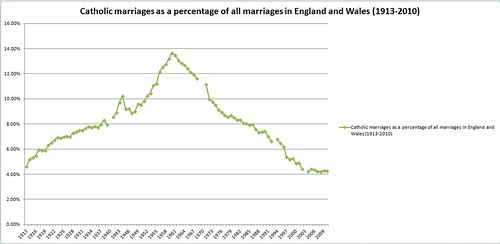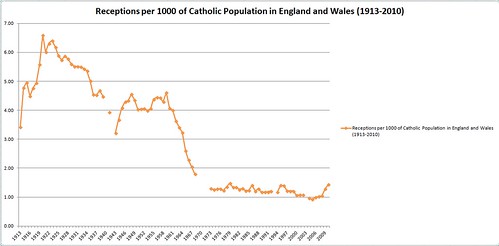The Tablet reported last weekend that the number of receptions at Easter this year will be the lowest for six years, having peaked in 2011. Not all converts are received at Easter, but one would expect the trends to be closely correlated. After the end of this graph, which goes up to 2010, then, it started going down again.
The 'bounce' in the number of conversions following the election of Pope John Paul II and Pope Benedict XVI does not seem to have been repeated by Pope Francis. The numbers of receptions was elevated after St John Paul's election for several years, his visit in 1982 gave it another filip, and his generosity to Anglican refugees from the ordination of women in 1992 was an even bigger boost. The last years of his pontificate, on the other hand, were not so good. Pope Benedict's election, which was more closely followed by his visit, had a remarkable effect. Pope Francis does not appear to have had a similar effect.
All of this, of course, pales into insignificance compared to the calamitous decline of the 1960s, of fully 70%, and takes no account of lapsation rates which were sky high in that decade, and have been serious ever since. The number of Catholic marriages as a percentage of all marriages is not a bad measure of the Church's health, and it is not very healthy.

But let's stick to receptions, it gives an indication of how attractive the Church is to outsiders. What drove the figures up and down? The impact of the World Wars is pretty obvious, as is things like new papacies. The cause of the really big drop is not so obvious. I've put in the dates of Vatican II, but the graph peaked in 1959. The liberals all point to Humanae Vitae, but it is hard to see what this has got to do with it, it was issued when most of the damage had already been done.
The simplest explanation is that the Church is more attractive, let us say to the people who might actually convert, when her message is clear. The election of two conservative Popes, St John Paul II and Pope Benedict, had a positive impact: that is undeniable. So did their visits to the UK, in which their conservative message was made with particular visibility. Humanae Vitae and Bl Paul VI's other conservative, dogma-reaffirming documents like Mysterium Fidei (1965) and the Credo of the People of God (1968) may have had something to do with the bottoming-out of the decline in 1971, along with the degree of liturgical stability brought about by the Novus Ordo Missae in 1970. The sense that anything was possible, that nothing was out of bounds, that the Church might do any kind of doctrinal 'back-flip', which was prevalent in the 1960s before, during, and after the Council, was obviously the worst possible message to send to sincere seekers after truth considering converting.
If you are thinking of converting, you'll want to know what is going to be expected of you. If it is all in a state of flux, you are going to hesistate. That's just obvious. If the flux carries on for an entire decade, this hesitation is going to have a disastrous effect on the number of new members.
But there is something more: even after the steep decline was arrested in 1970s, the Church was about a third as attractive as it has been on the eve of the Council. One might think that the peak of the 1950s was unsustainable, but if we consider conversions in relation to the Catholic population, it was less impressive than the situation between the wars.

The fact is that the Church had a very successful first half of the 20th century, and switched into an entirely different gear, a much lower gear, after 1960.
But this too makes sense on the basis of an analysis in terms of simple clarity of teaching. The pre-Conciliar Church was famous for its clarity. The liberals thought this was terrible, but it was attractive: along with other aspects of Catholic life, such as the much more stringent discipline, on fasting, holy days of obligation, and the marriage rules; in addition there was the traditional liturgy. These added up to a Faith which was demanding, and gave one a taste of the Mysterium tremendum.
Are you surprised? Frankly, if the Church can't present herself as serious, demanding, and holy, we can hardly expect people to flock to join.
Support the work of the LMS by becoming an 'Anniversary Supporter'.

If I'm reading the receptions graph at the top of this post correctly, the really steep decline in the 1960s starts in 1964, the same year Unitatis redintegratio was promulgated by the Council. How sadly ironic.
ReplyDeleteOf course, in fairness hardly anyone had read Unitatis redintegratio at the time - there was no internet, or general publication of the Council texts.
DeleteBut the lived reality on the Catholic ground was certainly detectable enough, a reality already shifting (really, even in the years before the Council) to reflect the messaging coming out of Rome. If potential converts were responding to anything, they were responding to that pastoral reality.
I think the impact of clarity of church teaching did have an impact, but only a secondary impact.
ReplyDeleteThe reason I think this is because another dramatic trend was going on in much of the Western world at precisely the same time; a trend that impacted the population as a whole and not just the Catholic population. And that trend was a drop off in births after a relative baby boom. One explanation that has been put forward for this is a relative income theory that argues that after the war, people had low material expectations and yet experienced growing affluence which together encouraged them to have children whereas the next generation had high material expectations and yet fewer opportunities that combined to discourage them to have children. Now I think that this same outlook that encouraged/discouraged children may very well correlate to some degree with an outlook that encouraged/discouraged people to/from Catholicism. After all if a society is so concerned with their standard of living they are going to sacrifice having children, then why would we expect many conversions to Catholicism?
But there is a secondary effect related to Church teaching. If the Church is not successful in its teaching then it is even more likely that this type of materialism is going to grow strong. And not only will we see less conversions but actual Catholics will be more strongly influenced by material aspirations and so more likely to likely to neglect their religion - which is also what has happened.
So if this is true, what does it tell us? Firstly, it confirms what Jesus told us about how wealth made it so much harder to enter the Kingdom. Secondly, it tells us that the Church has to focus more on immunising Catholics from materialism (and detaching non/lapsed Catholics from it). Obviously not easy - but relaxing fasting, compromising the element of mystery provided by the traditional liturgy and all those other attempts to fit in with the modern world seem to go in the opposite direction. And yet this is exactly the direction taken.
Well I'm going to be received this Easter anyway. Pope Francis is a bit puzzling sometimes, but he has not put me off converting.
ReplyDeletewelcome!
Delete1965 saw the start of the American cultural revolution ...
ReplyDeleteSome information is needed on those who are lapsing following reception. Daphne MacLeod has mentioned a figure of 80% within 5 years is now the norm.
At the risk of being left field but please do consider the situation in Sweden for example. A country with no rapport at all with Catholic Church. Sweden has effectively ceased to be Sweden in recent decades. It is effectively a "lapsed country", devoid of any hermeneutic of continuity. Sweden is unrecognisable from what it was in 1962. We flatter ourselves if we think we are alone in all of this.
A quick thought that combines some of the hypotheses above - how did the group of receptions that did so when marrying a catholic change as a proportion of total receptions? If the permissibility of mixed marriage without conversion came into general acceptance, then that might have affected overall reception rates. Likewise there is a missing consideration no one has mentioned - respectability and adherence. If one no longer has to have a religion - even one that is not taken too seriously - and can openly declare one is happily irreligious or not too bothered about it, then one could explain part of the drop. This might be measured in the number of baptisms by catholic parents over time - if everyone cared at the same rate over time, the per capita/per 1000 rates wouldnt change, but I would predict they would drop post-mid-6os (assuming the drop off takes an extra ~5 years to kick in because of marriage-childbirth gaps), and also because not being received is a 'background' fact, it is a non-barking dog. By contrast, for example - when a catholic has to have the conversation like "Nah, Im not going to baptise them, I think they have to choose their own path when they are mature" position to fellow catholics it takes a bit more impetus and boldness to do. That takes a bit of time and a bit more situational apathy to get away with and not be shocking, and for people to be comfortable enough with their family's and neighbours' reactions to do it. While the 'I think my child can choose his own religion' is a minority position, one has to have a pretty relaxed social atmosphere for it to actually become socially noticeable, as it is in some western countries.
ReplyDeleteThis makes a more general consideration - perhaps one should also distinguish engaged religious converts, ideological converts (!) and those who are going along with reception for some or other social reason. After the 60s, the latter group fade out, the ideologues - who knows? - seem to go up after the women priests issue for example, and one could suppose that sincere religious conversions keep puttering along, but these were historically a minority. (Just because the amount of people who are engaged in religion in a population is not that high).
(* The distinction of religious engaged and ideologue is a rough and ready distinction, and not to be used for ahem...ideological purposes)
(** I do not suggest these things to exculpate the current ways of doing things, but rather to suggest it might be more multifactoral and actually more banal causally than titanic struggles over papal documents and liturgies).
I had the same idea you did when looking at the graphs — I wouldn't be surprised if more than half of converts in the West were "married" into the Church.
DeleteAmong my mom and her eight siblings, three married protestants (including my dad) who converted because of them. (This is in America.)
when did the prohibition of mixed marriages subside at the parish level?